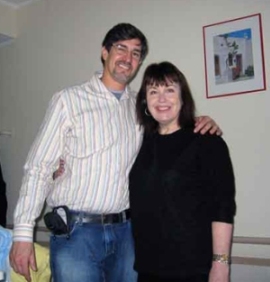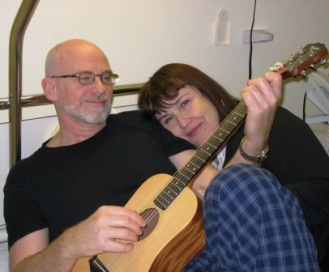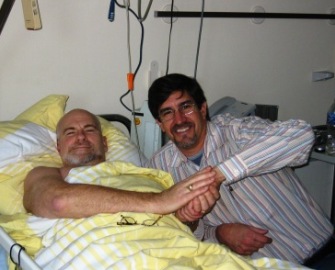|
|
|
|


Ken and Jennifer at St. Peters

Mark
and Jennifer
|
|
From:
|
|
Ken |
Sent:
|
|
Friday,
December 07, 2007 1:30 PM |
To:
|
|
Mark
Mintzer |
Subject:
|
|
THANK
YOU!!!
|
Dear
Mark,
My recovery has progressed much
as we had hoped it would. Hopefully the next 6 months will continue
to show improvement.
I want to thank you for the role you have played in my return to a
life. I was following the suggestion of another German spine surgeon
when I
first contacted you, and I did so because my pain level and the limiting
condition of my spine prevented me from doing
that what was necessary to obtain information needed to determine
if I should proceed with ADR. Medication and constant high level of
pain had severely restricted my ability to gather and analyze. I could
not sit long enough to review websites.
And
yet, when I spoke with you I began to sense that you were acutely aware
of the difficulties I
was encountering. Your answers were clear and conveyed with compassion
and patience,and without judgement. Thereby, you made apparent
that your ability to understand, and appreciatively respond, was the
gift of having shared the same experiences.
Having yourself undergone ADR, and assisting so many others,
you understood the questions I was struggling to formulate.
Mark,
as my condition rapidly deteriorated Jennifer and I began to ask you
to become involved in travel
arrangements, scheduling, and communications with the doctor's office.
I appreciated that you did not "sugar-coat" the details
of what we were going to do (recovery, testing,etc). When things
were
going to be very painful and challenging you stated so, yet...you
never
forgot what it was like when you were making similar decisions and
you remembered to remind me that good results were possible.
Eventually, Jennifer and I made the decision that as ADR was our only
chance of having an acceptable
quality of life, it was critical to do everything possible to stack
the odds in our favor. We decided that would include the services of
Global Patient Network, and
meeting you in Germany.
Also, I knew that I would not be able to help Jennifer on the last
leg of the trip from Munich to Bogen. The concern was very great
that Jennifer would be expended on getting me there, and that assistance
from GPN was important to enable her to be at her best when she was
most
needed.
The
first time we met, when you got us through customsand secured our baggage,
I was confident I had made the correct decision.Your personal experience,
and insight gained from
having helped so many others had a positive impact on the success of
my ADR.

The worst
is over.
|
|
So
often Mark, I meet people who ask about my experience with
ADR, people who are themselves dealing with a deteriorating
spine. Most often they are nearly overcome with despair and
hopelessness. I share my story and give them the websites of
the doctors I considered. Importantly at this their initial
stage of considering ADR, I also give them detailed information
as to how to contact you. The services you and Global Patient
Network can provide were a turning point in my return to life.
I know I'll be speaking with you again very soon. Right now,
it's a pretty day and I am going for a walk.
Thanks
again for your role in making this possible.
Ken |
|
|
Mark
here... I
have to say a few things about Ken's case. First, the surgery was one
of the most amazing things I've ever seen. Ken had a
substantial curve that
was
destroying his spinal balance and was likely a huge factor in how bad
his spine had become. The origin of the curve
was probably due to a wedge shaped L3 vertebral body. Since his
spine was VERY crooked
to start with,
as Dr. Bertagnoli
put in the three artificial discs that surround the fusion, every thing
was all misaligned. Keels were pointing in every direction and nothing
seemed to be aligned. I kept quiet, but I was very concerned about
what the final configuration was going to look like. After all three
ProDiscs
were installed, he cut a wedge shaped piece of bone away from the misshapen
vertebral body. He then put carbon fiber cage filled with morselized
bone on the right side of the L3-4 disc space. I'd never seen these
cages put
in oriented this way. He put another cage in on the left side of the
disc space. Dr. Bertagnoli was using 2 cages where there would normally
be one.
They were turned 90 degrees to normal orientation. Then I could see
what Dr. Bertagnoli intended. Because removing the wedge of bone compromised
the endplate, he required much
greater than
normal coverage
of the vertebral body. Even with augmenting the bone strength with
vertebroplasty,
he was concerned about subsidence and the best way to avoid that was
by
getting as close to 100% coverage as possible. Things started to look
a little better, but all the keels were still all off-kilter. The
disc
space
was still
very wedge shaped. The cage on the right seemed to be pretty tight,
but the cage on the left was very loose. I was worried.
Dr. Bertagnoli then made a hole in Ken's left side and created access
to the spine from an extreme lateral angle. This is the ALPA approach
that he pioneered and is still state of the art and used today with Nuvasive's
XLIF and MAXCESS systems. After placing the screws in L3 and L4, Dr.
Bertagnoli joined them with a threaded rod. As he tightened the system,
the threaded rod functioned as a jackscrew and changed the wedge shaped
disc space that had left one of the cage all loose and floppy, into a
very tight system. When the endplates were parallel, both cages were
beautifully aligned and clamped firmly around BOTH cages. It was the
most amazing thing to watch as all of the keels that were pointing in
different directions were magically pulled into alignment as he pulled
the endplates parallel. This was not the first time that I saw Dr. Bertagnoli's
engineering background allow him to perform wonders in the OR!
The
second thing I have to tell you is about the time I spoke to Ken at
about 5 months post op. As we spoke, he was describing pain
levels and medication levels that really gave me pause. I was worried
about his outcome. Here is what our conversation
was like:

After
a tough few days,
Ken can smile again (just for a second!)
|
|
Mark: "Ken,
it sounds to me like you are describing an unsuccessful outcome.
But, you were out of breath when you answered the phone...
what were you doing?"
Ken: "I
was out in the backyard throwing the football with my sixteen
year-old!"
Mark: "Could
you do that before the surgery?"
Ken: "Hell
no! Mark, I was in bed 22 hours a day before the surgery."
Mark: "What
is your life like now?"
Ken: "I
can get out and run errands, I can drive, I can go to my
sons football games, I can do things on my own, I can function
so much better than before!"
|
|
|
What constitutes surgical success may be different for all of us.
Pain free, medication free may not be a reasonable expectation, especially
in such an extreme case. It's great to know that at 5 months, even with
such pain and continued medication use, Ken's life was so much better.
At 1 year post-op, when Ken's email was written, he had continued to
improve. I look forward to more positive updates!
All the best,
Mark
|
|  |
|
|

